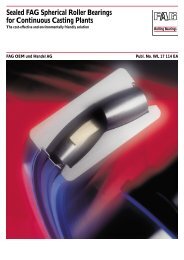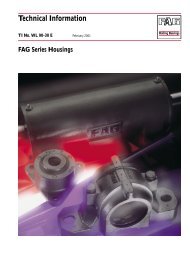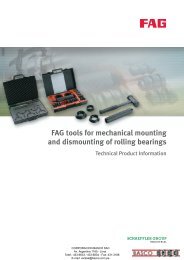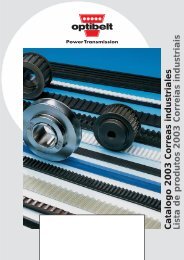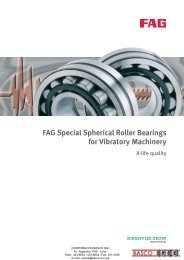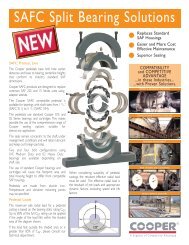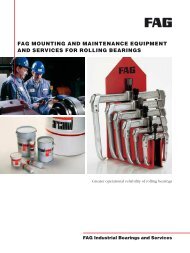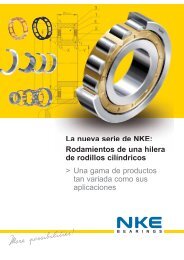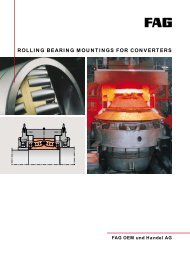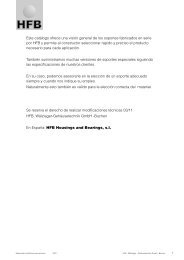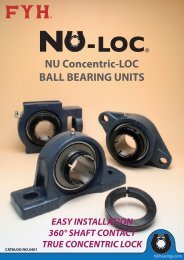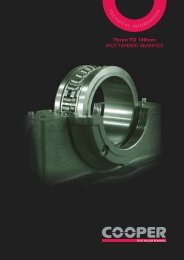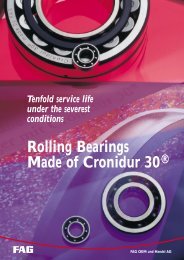You also want an ePaper? Increase the reach of your titles
YUMPU automatically turns print PDFs into web optimized ePapers that Google loves.
1 Traction motor for electric standard-gauge locomotivesOperating dataThree-phase current motor supplied by frequencyconverter.Nominal output 1,400 kW, maximum speed4,300 min –1 (maximum driving speed for transmissionswith standard gear ratios is 200 km/h). One-enddrive with herringbone gear pinion.<strong>Bearing</strong> selection, dimensioningCollective loads which cover representative load casesfor the motor torque, speeds, and percentages <strong>of</strong> timefor the operating conditions in question, are used todetermine bearing stressing.Load case . . . . . . . . . . . . . . . . . . . . . . . . . . . . . . . . .M d n . . . . . . . . . . . . . . . . . . . . . . . . . . . . . . . .qN m . . . . . . . . . . . . . . . . . . . . . . . . . . . . . .min –1 %1 6,720 . . . . . . . . . . . . . . . . . . . . . . . . . . . . .1,056 22 2,240 . . . . . . . . . . . . . . . . . . . . . . . . . . . . .1,690 343 1,920 . . . . . . . . . . . . . . . . . . . . . . . . . . . . .2,324 184 3,200 . . . . . . . . . . . . . . . . . . . . . . . . . . . . .2,746 425 2,240 . . . . . . . . . . . . . . . . . . . . . . . . . . . . .4,225 6<strong>The</strong> collective load is the basis for determining theaverage speeds (2,387 min –1 ) and the average drivingspeed (111 km/h). For each <strong>of</strong> the load cases the toothload acting on the pinion and the reaction loads fromthe bearings have to be calculated both for forward andbackward motion (percentage times 50 % each).In addition to these forces, the bearings are subjectedto loads due to the rotor weight, the unbalanced magneticpull, unbalanced loads and rail shocks. Of theseloads only the rotor weight, G L , is known; therefore, itis multiplied by a supplementary factor f z = 1.5...2.5 –depending on the type <strong>of</strong> motor suspension. <strong>The</strong> bearingloads are determined from this estimated load. Forthe spring-suspended traction motor shown, a supplementaryfactor f z = 1.5 is used.<strong>The</strong> bearing loads from weight and drive allow the resultantbearing loading to be determined by vectoraddition. In this example only the critical transmission-endbearing will be discussed. <strong>The</strong> attainable lifeL hna1...5 is determined for every load case using the formulaL hna = a 1 · a 23 · L h [h], taking into account theoperating viscosity <strong>of</strong> the transmission oil at 120 °C,the rated viscosity 1 as well as the factors K 1 and K 2 .<strong>The</strong> basic a 23II factor is between 0.8 and 3. <strong>The</strong> cleanlinessfactor s is assumed to be 1. <strong>The</strong>n, L hna is obtainedusing the formula:L hna =100q 1 q + 2L hna1 L hna2q + 3L hna3+ ...When selecting the bearing it should be ensured thatthe nominal mileage is reached and that, due to thehigh speed, the drive-end bearing is not too large.With the bearings selected the theoretical mileage <strong>of</strong>2.5 million kilometers required by the customer can bereached.A cylindrical roller bearing FAG NU322E.TVP2.C5.F1serves as floating bearing at the drive end; an FAG566513 with an angle ring HJ318E.F1 serves as thelocating bearing.<strong>The</strong> cylindrical roller bearing FAG 566513 is anNJ318E.TVP2.P64.F1, but its inner ring is 6 mmwider. <strong>The</strong> resulting axial clearance <strong>of</strong> 6 mm is requiredin order to allow the herringbone gearing on thepinion to align freely.Suffixes:ETVP2C5F1P64reinforced designmoulded cage <strong>of</strong> glass fibre reinforcedpolyamide, rolling element ridingradial clearance larger than C4FAG manufacturing and inspectionspecification for cylindrical roller bearings intraction motors which considers, amongothers, the requirements according to DIN43283 "Cylindrical roller bearings forelectric traction".tolerance class P6, radial clearance C4Machining tolerancesDrive end: shaft r5; end cap to M6Opposite end: shaft n5; end cap to M6<strong>The</strong> bearings are fitted tightly on the shaft due to thehigh load, which is sometimes <strong>of</strong> the shock type. Thisreduces the danger <strong>of</strong> fretting corrosion, particularly atthe drive end.<strong>Bearing</strong> clearanceDue to the tight fits, the inner ring <strong>of</strong> the bearing isexpanded and the outer ring with the roller-and-cageFAG 6



